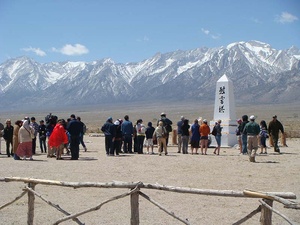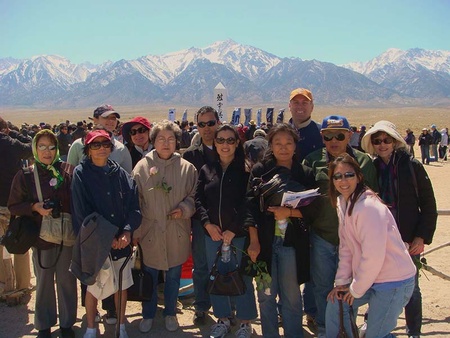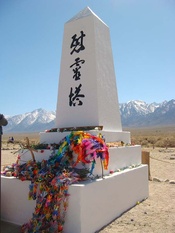Read Part 17 >>
Post-script
My exploration of the Mananzar photographs of Adams, Lange, and Miyatake, along with my readings of the historical, memoir, and fictional accounts of the Japanese-American concentration camps brought me a deeper understanding of the hardships, both physical and psychic, my own family and all of those incarcerated faced. Attending the 40th annual Manzanar pilgrimage in April 2009, I pictured the rows and rows of barracks as they must have looked in 1944, a long line of prisoners snaking around the mess hall, groups of children jumping rope, old men playing games of go in the sparse shade.
I understood how these memories, for those who had been there, would be poignant and sometimes melancholy. Yet I also understood how, for some of those who came of age in the prison camps—members of the roving packs of teens who wandered from mess hall to mess hall in search of the best food and established lifelong friendships—those years would be remembered as among the most vital of their lives.

Young, old, Buddhist, Christian and Muslim pilgrims gathered at the Manzanar cemetery fort he 40th annual Manzanar Pilgrimage. (Photo courtesy of Nancy Matsumoto)
For many Japanese Americans this annual pilgrimage assumed a new relevance after the events of 9/11, including the illegal detainment of non-U.S. citizens suspected of terrorism at Guantanamo Bay, the harassment of Muslims living in America and, the public airing of Justice Department memos exploring its legal accountability for abusive interrogation techniques and torture. For Japanese Americans of my parents’ age, this latest era of race hatred and disposable civil rights is déjà vu all over again. The prominence of Muslim hijab headscarves and the large number of college groups at the pilgrimage lent the proceedings an air of both urgency and energy.
Near the prison camp cemetery, dominated by the large ireito, or memorial obelisk, rows of folding chairs were set up in front of a flatbed truck-turned stage festooned with koinobori carp streamers symbolizing courage and strength. Bruce Embrey, co-chair of the Manzanar Committee, told the gathered crowd, “Every year since 9/11, we come to the site with new faces, we hear new prayers offered, and we hear another community speak the same words our grandparents and our fathers and mothers spoke: ‘We are not enemy aliens, we are not traitors. We are not spies and we are not terrorists.’ We come here with one simple demand: Never again.”
That year’s pilgrimage fell almost exactly 67 years after my father made the trip at age 13; I realized that he was then the same age my son. I imagined him making the 230-mile trip from Los Angeles, not in air conditioned luxury, but squeezed into a fetid bus, black-out shades pulled down tight, wondering where he was headed, perhaps fearing being shot or bayoneted at the end of the line. Knowing the insecurities and vulnerabilities of this age so well made the thought of the inner turmoil he must have experienced as painful to bear.
The photographs that I took that day were mere snapshots, my family group lined up in rows, smiling against the backdrop of the Sierra Nevada, the tip of the ireito just visible above their heads. They looked cheerful, any reflective thoughts that might be passing through their minds hidden behind their grins. I spotted Archie Miyatake, a bulky digital camera slung around his neck, wandering through the cemetery, and called him over to introduce him to Uncle George. They were nearly the same age, were at Manzanar at the same time and yet they did not know each other, though to my uncle Archie was a well-known figure. The two men exchanged a few words of greeting, then Archie quickly excused himself. He wanted to document the simple circle of stones with the rough-hewn miniature obelisk at its head—a recreation of Manzanar’s first grave that Dorothea Lange photographed in 1942—before the pilgrimage ended and the buses returned home.

The Matsumoto family gathered at the 40th annual Manzanar Pilgrimage. (Photo courtesy of Nancy Matsumoto)
(END)
© 2011 Nancy Matsumoto






